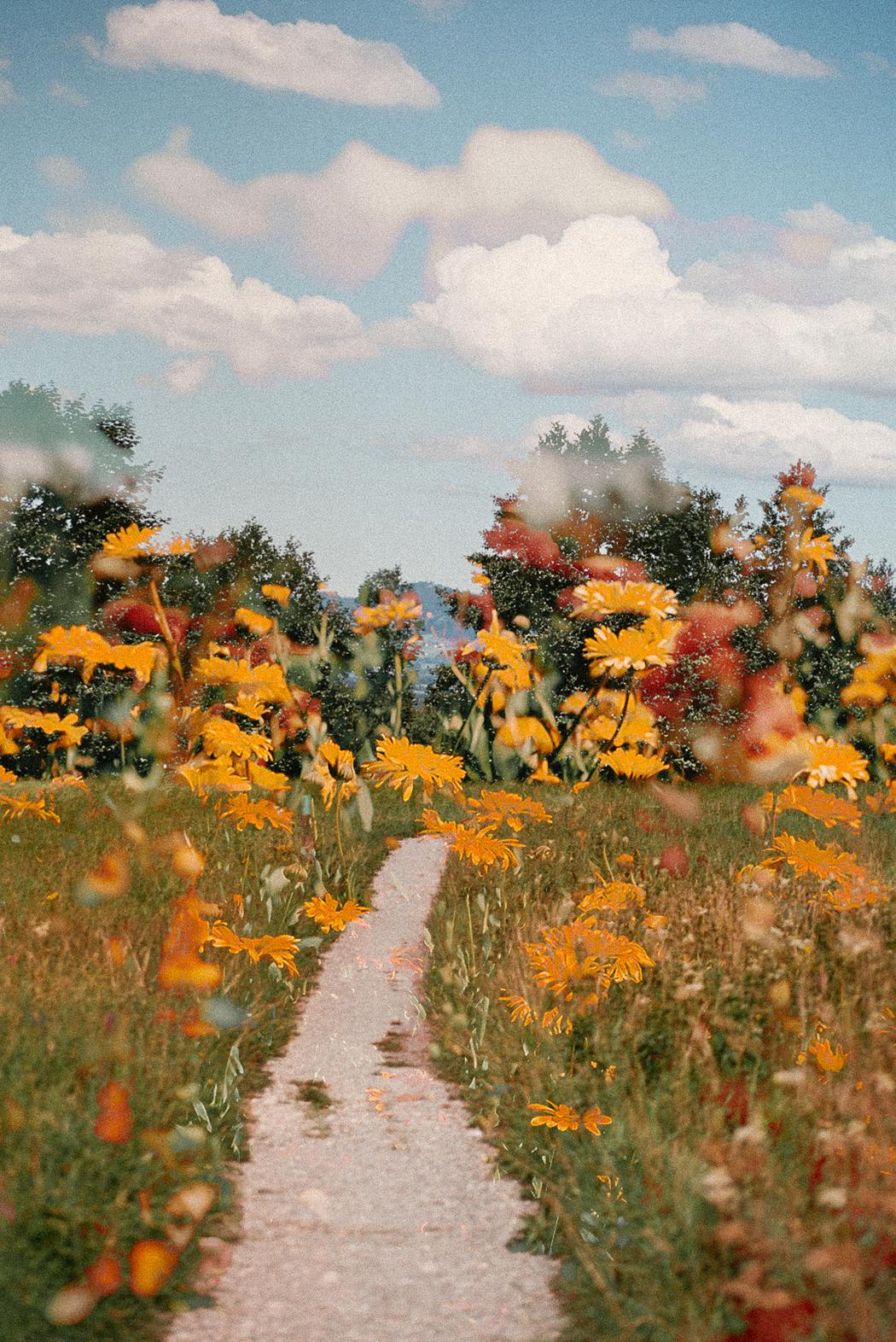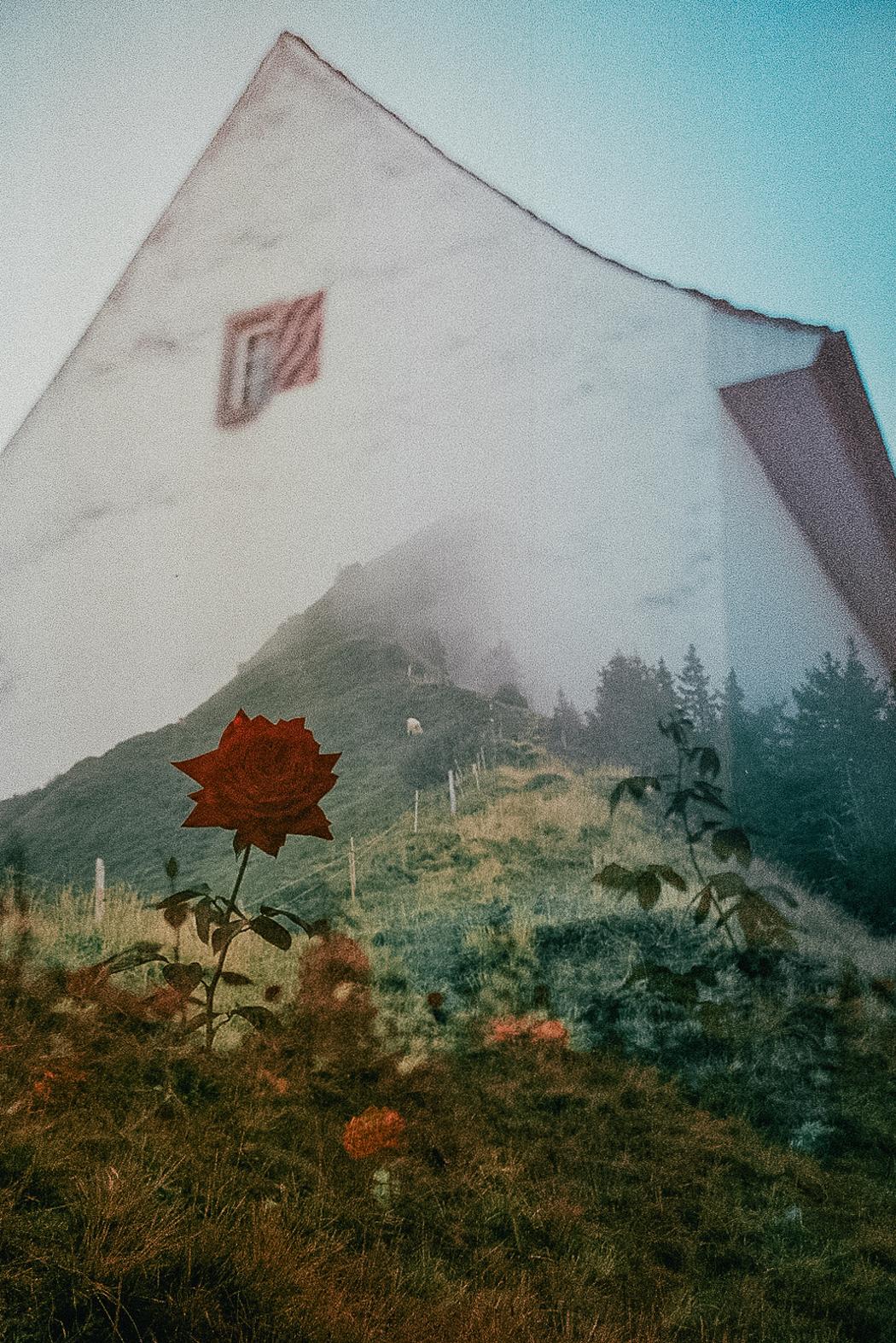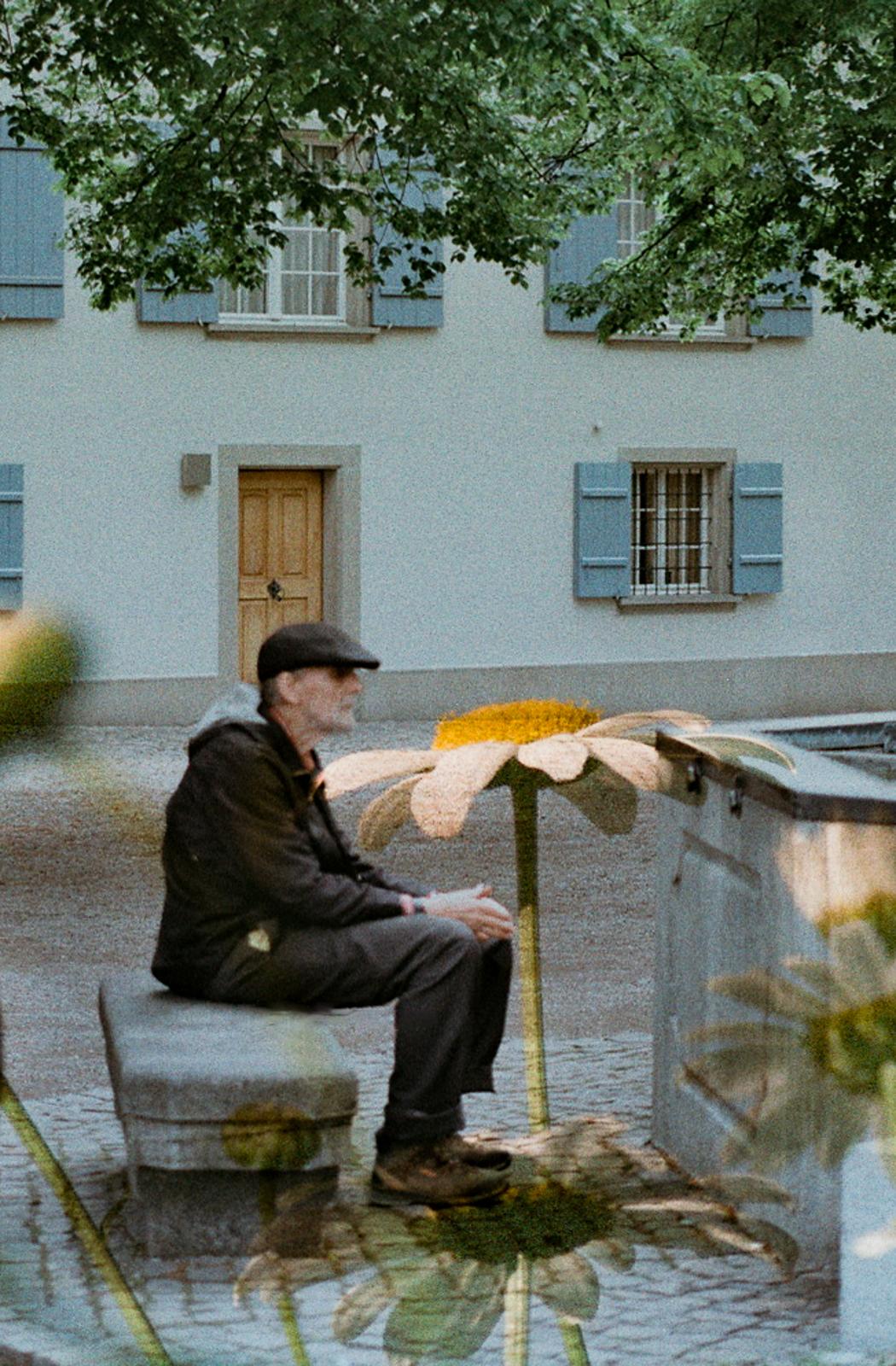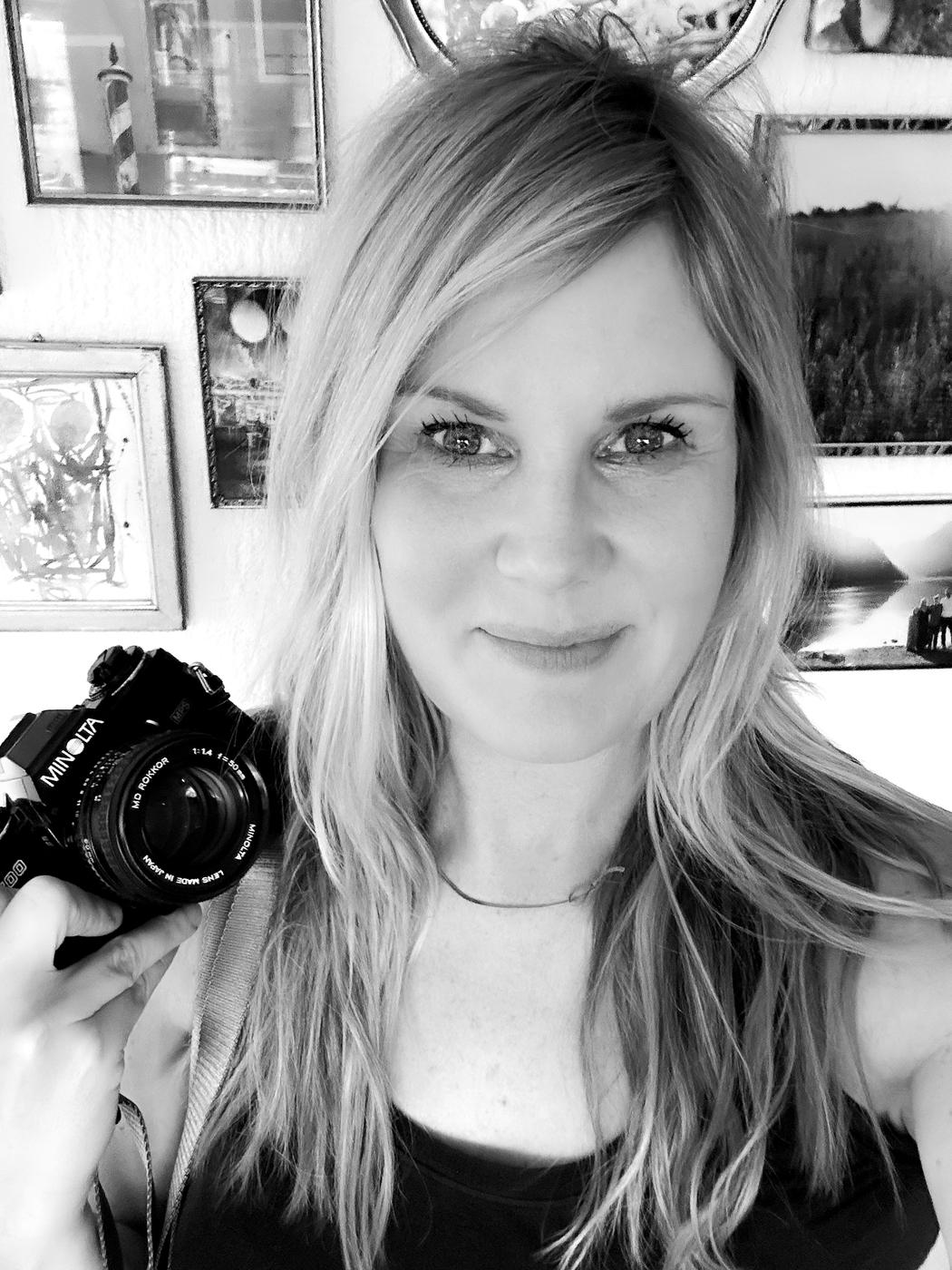Juleah Claar
Year of birth: 1978
Where do you live: Wädenswil, Switzerland
Your education: Bachelor of Arts in Anthropology, Masters in Business – Project Management, Advanced Study Photography
Describe your art in three words: unexpected, observant, evocative
Your discipline: Analog film photography, street photography, and experimental double exposure
Website | Instagram
Can you tell us about the moment you decided to return to photography after your corporate career?
In 2012, shortly after the birth of our first child, I left my corporate job. I knew I wanted to return to something more creative eventually, but at the time, I stepped fully into motherhood. Life was full, and my identity shifted, as it does for so many new parents.
By 2016, with two young children in tow, our family relocated to Switzerland for my husband’s job. I suddenly found myself in a completely unfamiliar environment—new language, new culture, no extended support system. It was disorienting. To stay connected with loved ones back home, I began taking casual photos on my phone, capturing small glimpses of our new life abroad.
Something unexpected happened. Friends and family began commenting on my images, saying I had “an eye” for detail or that I captured moments others might overlook. I brushed off the compliments at first. But the feedback kept coming. That Christmas in 2016, I bought my first digital camera. At first, I used it casually, capturing Swiss landscapes and city life. I had started an Instagram account after moving abroad that I never posted to, but then I began sharing more intentionally. The day I made my account public at the end of 2017, one of my photos was picked up by a Zurich tourism website. Then it happened again… and again. Soon, my images were being regularly featured by local social media platforms. That external validation gave me the confidence to take photography more seriously.
By 2018, I craved more technical knowledge and enrolled in an 10-month advanced study photography course. It was my first formal training since high school, when I had learned to shoot and develop film in a darkroom.
Then in 2021, I found myself drawn back to film photography (which I hadn’t touched in 25 years). After years of honing my skills with digital, I was looking for a new creative challenge—something more tactile, more unpredictable. Film offered exactly that. I’ve always been attracted to imperfection, and film embraces it beautifully. The grain, the softness, the mood it evokes—it all feels more like storytelling than image-making.
What began as a way to document a new chapter of life gradually evolved into a deeper creative practice. Photography, especially through the lens of film, has become more than a hobby; it’s a way of seeing, feeling, and connecting—with the world around me, and with myself.
How has your background in anthropology influenced the way you observe and capture everyday life?
I bounced around nearly every major in college before stumbling into an introductory anthropology course. From the first few lectures, I was hooked—drawn in by the desire to understand how people live, interact, and make meaning within their environments. That curiosity never left me. Even today, cultural festivals often move me to tears. There’s something deeply human about shared rituals and traditions, and I think that emotional response traces directly back to my anthropology roots.
That foundation has profoundly shaped the way I see the world—and how I photograph it. Anthropology teaches you to slow down, to observe without immediately interpreting, and to pay attention to the stories unfolding in everyday life. Whether I’m capturing a quiet city street, a centuries-old Swiss tradition in the Alps, or the rhythm of daily routines, I’m always looking for those subtle moments that say something about people and place.
Photography has become a natural extension of that mindset. It allows me to document life as it truly is: unscripted, nuanced, and layered. I’m not just chasing beautiful images; I’m chasing meaning. Often, it’s the smallest details—a gesture, a texture, a glance, a shadow—that tell the most powerful stories.
 Juleah Claar | Meadow Daydream | 2022
Juleah Claar | Meadow Daydream | 2022
What drew you to the technique of film double exposure?
Double exposure on film felt like a natural evolution in my creative process. I had already returned to film because I was craving something less controlled and more experimental than digital photography. With double exposures, that sense of unpredictability is amplified—and that’s exactly what draws me in.
There’s a kind of magic in layering two moments into a single frame. It challenges how we see and interpret an image. Sometimes the results are planned, but often they’re completely accidental. And more often than not, those surprises end up being the most compelling. It’s a technique that forces you to let go of perfection and lean into intuition and chance.
I often shoot with expired film and older cameras with light leaks, which add an extra layer of unpredictability. The way colors shift, fade, or intensify over time creates textures and tones that digital photography simply can’t replicate. It’s a celebration of imperfection in the most beautiful way.
I would say double exposure echoes my background in anthropology. It’s about layering context and meaning, seeing how two seemingly separate things can coexist in one space and form something new. It invites the viewer to slow down and search for connections—to look between the layers. That sense of storytelling is what keeps me coming back to it. And honestly, it’s just a really fun and creative outlet.
How do you choose which images to combine in your “Film Fusion” project?
Film Fusion is rooted in the idea of visual storytelling through unexpected combinations. I usually begin with a feeling or theme I want to explore—something atmospheric, surreal, emotional, or connected to a sense of place. From there, I sift through my film archive, looking for frames that might complement that mood—whether through light, color, texture, subject matter, or tone.
I’m especially drawn to pairings that create contrast or tension. That might mean blending a natural landscape with stark urban architecture, or layering a quiet portrait over the chaos of a street scene. I often experiment with multiple combinations, playing with different overlays until something clicks. Many of those experiments never make it past the cutting room floor, but the process itself is part of the fun.
The images I ultimately choose aren’t about technical perfection—they’re about evoking a feeling. Sometimes the result is dreamy and poetic, other times a little disorienting or strange. That’s the heart of Film Fusion for me: letting go of control, embracing imperfection, and discovering something new in the overlap.
 Juleah Claar | Nature Reclaims | 2022
Juleah Claar | Nature Reclaims | 2022
Many of your photos explore contrast and ambiguity—what role does emotion play in your compositions?
Emotion plays a central role in how I approach and select images. I’m often drawn to scenes that feel a little offbeat, quiet, or in-between—moments that aren’t overtly dramatic but carry an emotional undertone you can’t quite name. That sense of ambiguity is something I intentionally lean into.
Contrast is one of the tools I use to bring those emotions to the surface—whether it’s light and shadow, stillness and motion, or solitude and connection. Sometimes two images that feel emotionally neutral on their own, when layered together, suddenly spark something unexpected. That juxtaposition can create tension or tenderness—or both—and often evokes a deeper emotional reaction than either image would alone.
I don’t go into a shot trying to capture a specific feeling. Instead, I pay attention to the mood of a scene and trust my instincts. It’s less about telling a clear story and more about creating space for interpretation. I want viewers to bring their own experiences and emotions to the image.
In that sense, emotion isn’t just something I try to capture—it’s something I try to evoke. Whether through composition, color, or layering in my Film Fusion work, I want each image to carry a kind of emotional texture: subtle, layered, and lasting.
Do you approach photographing people differently from photographing nature or architecture?
Yes, definitely. Each subject calls for a different way of seeing—but my approach is always grounded in observation and spontaneity.
When I photograph people, especially in street photography, I shoot candidly. I don’t interact or intervene—I’m trying to capture something genuine and unposed without disrupting the moment. It’s quick and instinctive. I take a lot of frames, knowing that the moment I’m after might only last a second. I’m watching for subtle gestures or interactions that feel real and human.
When I’m photographing architecture or street scenes without people, my mindset shifts. I’m still working intuitively, but now I’m focused more on composition—on how light moves across a wall, how shadows fall, how colors and lines come together in the frame. It’s less about timing and more about how the elements relate visually.
Nature photography allows me to slow down. It’s the one time I feel like I can take a breath. I still shoot instinctively, but there’s more space to be present—to notice texture, light, and quiet details. I’m drawn to calm, often minimal scenes in nature—where feeling replaces action.
So yes, my approach changes depending on the subject—but in every case, I’m looking for something honest, something quietly striking, and often something unexpected.
 Juleah Claar | Solitude In Bloom | 2022
Juleah Claar | Solitude In Bloom | 2022
Can you share a story behind one of the photographs in this series?
One image that stands out to me is titled Solitude in Bloom. It’s a double exposure that combines two very different moments—brought together purely by chance, but somehow speaking the same emotional language.
The first frame shows an older man sitting quietly on a bench in one of Zurich’s busiest squares. All around him, people were snapping photos, enjoying the sunshine, and taking in the lively energy of spring. And yet, he remained still—completely present, watching birds circle the fountain and observing the world unfold around him. There was something quietly powerful about his calm in the middle of all that motion.
The second frame is a close-up of wildflowers I photographed during a walk with my dog. It was one of those unexpectedly beautiful afternoons—the sky an intense, saturated blue, made even more vivid by the 20-year-old expired film I was using. The colors came out surreal, dreamlike.
When these two frames overlapped, they created something I hadn’t planned: a visual meditation on stillness, solitude and the bloom of life around us. What I love is that these images were taken exactly 20 rolls apart—no connection in time or space, and yet they speak to each other so clearly.
That’s the beauty of film double exposure. I never pre-plan the pairings. The meaning often reveals itself only after the fact, in ways I couldn’t have anticipated. It’s unpredictable, and often deeply personal—like finding a story you didn’t know you were telling.


Leave a Reply
You must be logged in to post a comment.